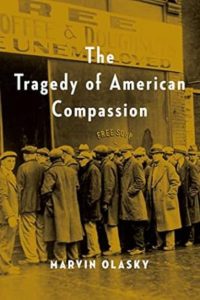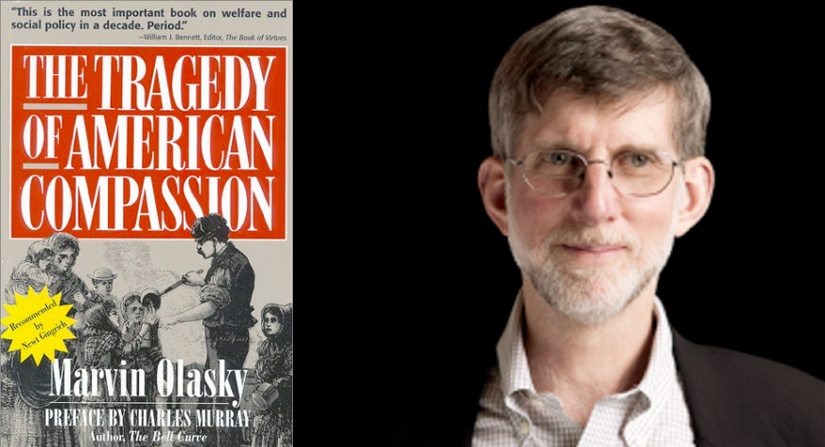Review: The Tragedy of American Compassion by Marvin Olasky
A review by James Whitford
Marvin Olasky’s Tragedy of American Compassion is an in depth review of the history of American charity and its contrast to the welfare system. The author begins with a brief overview of charity in colonial America remarking on the emphasis that charity workers placed on balancing mercy with justice in two primary ways; truly knowing the individual they were helping and being willing to withdraw support when appropriate. Along with these two principles, he highlights the importance faith, education, family, industry, forethought and self-restraint played in poverty alleviation.
He also differentiates “poverty” and “pauperism,” a persisting distinction throughout the text. Those in poverty are the working poor while those poor who are lackadaisical or “unnecessarily dependent” are paupers.
Tocqueville is introduced at the end of the opening chapter to contrast the already growing European welfare state and the personalized charity of new America. It leaves the reader with an enticing question: Why would America shift back toward a government-based centralized method of helping the poor?
Chapter two introduces Thomas Chalmers, an early 19th century Scottish theologian in Glascow. He created “charity zones” in which discriminate giving was emphasized and government aid excluded. The model was soon copied in America first through the Society for the Prevention of Pauperism and then later through the New York Association for Improving the Condition for the Poor (AICP). The focus of these organizations was to distinguish the “worthy poor” through personal investigation and involvement. Other similar works are highlighted including one in Boston that developed a “black list” of 201 “able-bodied persons who refused to work.” Olasky remarks that the goal of such organizations was “to make city relations as much as those of the countryside” where love and discipline were married and rights with obligations were the rule of thumb. And, in fact, Olasky spends some time on the discussion of pauperized children in Manhattan being taken in voluntarily by more rural families, the outcomes of which were painted overall as positive but not without the hint of occasional and tragic abuse.
Chalmers and others argued that governmental relief would fatigue charity workers and crowd private charities out and that elected officials giving doles to the poor or workers being paid to do so would be conflicts of interest that should not be ignored. Nonetheless, these types of government solution ideas began to prevail. Primarily, Horace Greeley, founder of the New York Tribune and a Social Universalist promoted that “all men have an equal right to an equal share.”
This thinking became more prominent in the mid and latter 1800’s resulting in a growing consensus that any humane government should care for its poor. Olasky implies a connection between the universalistic thought and indiscriminate giving that “goes berzerk” in the latter 1800’s within larger cities. The exasperation of endless lines of people seeking “outdoor relief” (which he paints as not only indiscriminate but also demoralizing and depersonalized) led to a growing counter-thought: Social Darwinism. This ideology, defined as a natural and “beneficent purging of the social organism” by “excreting the unhealthy, imbecile and slow members of society” is discussed at length.
Olasky indicates that between the universalistic and darwinistic camps, true charity and effective compassion reside. He applauds the work of Humphrey Gurteen’s Charity Organization Society in Buffalo in the 1890’s that established work tests to determine those deserving of relief and Josephine Lowell who condemned indiscriminate giving and required “investigating applicants” before distributing resource.
Before the turn of the century, outdoor relief was out and the thoughts of Gurteen and Lowell were in. Scores of “points of light” charities and their successes are highlighted in chapter five as they employ Olasky’s seven marks of compassion:
- Affiliation: Reconnection or involvement of family
- Bonding: Personal relationship development with the poor
- Categorization: Different individuals require different help
- Discernment: The tool for categorization provided through bonding
- Employment: Work should be required
- Freedom: Liberty to rise or fall
- God
Before the Great Depression, Olasky notes an unfortunate return toward a universalistic “social gospel” movement. This was born much from a change in perspective; one that viewed the forest rather than the tree. That is, the presence of poverty in general distracted many from a continued belief that focusing on the one was society’s answer. The focus led to attempts to organize city charities through “Charity Organization Societies” that would screen applicants before referring them to various points of light and for those who favored government answers, the pressure for a grand solution bolstered the Universalist’s hope of a welfare state. In the eighth chapter, Olasky descriptively portrays the excitement of America at the turn of the 19th century. The energy and pervasive hope of a solution to all of society’s poverty-related problems took the previously mentioned “social gospel” one step further; that if man is provided the right environment and the right amount of aid, immorality including laziness, theft and the like would simply cease. This re-awakened “Greely-concept” turned even more of the populous to believe that the centralizing power of government would be the only way to provide such a utopia. And in 1909, under the Taft administration, the first real vision of a federal welfare program is launched at the “White House Conference on the Care of Dependent Children” proposing aid to children, widows and single mothers. Although not noted by Olasky, this reviewer found it ironic that this was the very year in which the 16th amendment was proposed that would later constitutionalize the federal income tax.
Concomitant with the onset of the Depression and Roosevelt’s New Deal, the field of social work took a prominent place in charity effort. Olasky indicates this “professionalization” of charity leads to less voluntary involvement and relaxes the conviction to give financially. In chapter 10, the tragedy worsens. In hopes of the Great Society of the 1960’s, the author indicates a shift in public opinion from poverty’s solution found in right relief to relief as a right. This new war on poverty propagated more than a thousand “neighborhood service centers,” the goal of which was to establish welfare benefits as rights and convince all that dignity and dependency could, in fact, co-exist. This new “recruitment” approach fit hand in glove with the National Welfare Rights Organization that had a focus on “mobilizing the poor” as it trained them “to demand payments, not ask for them.” Olasky remarks here that many churches had, by then, succumbed to the notion that social justice equates to material wealth.
In the concluding chapters, Olasky points out three “big losers” evident in the 1970’s and 80’s: 1) Social mobility, that is the freedom to rise or fall, 2) private charities and 3) marriage. He argues that welfare at that time dis-incentivized risk to get off the dole, that its ample availability competitively crowded out private charities that challenged their clients and that it replaced the provider role in the household diminishing the importance of marriage.
In the final two chapters, Olasky delves into the word “compassion” and specifically the change of public definition. He remarks that compassion is now more measured by material distribution than by application of personal challenge and requirement of responsibility. Regarding compassion as the proper and physical expression of charity, he claims from a Biblical perspective that compassion should be conditional and carefully applied as opposed to “Velcro compassion” that is applied with ease and one size that fits all. In conclusion, he argues that true compassion is not what America models today, but more than 100 years ago when personal involvement led to personal challenge and an impetus to take the hand up and raise oneself from the mire of poverty.

This article is just the tip of the iceberg for the practical resources available through the True Charity Network. Check out all of the ways the network can help you learn, connect, and influence here.
Already a member? Access your resources in the member portal.



